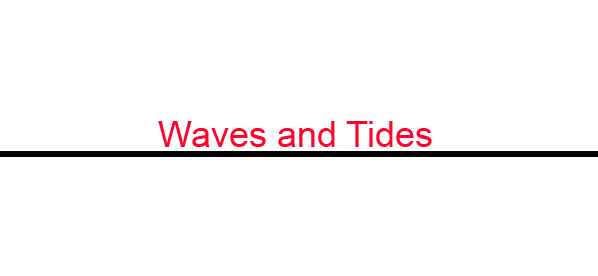
Waves and Tides
•The movement of ocean waters takes place in three different ways, viz waves, currents and tides.
•Waves are a most conspicuous feature of oceans. They are oscillatory movements’ water, manifested by an alternate rise and fall of the sea surface.
•The top part of a wave is called its crest and the lower part between two waves is the trough.
•Waves are mainly produced by winds.
•The size and force of waves depend on three factors:
I.The velocity of the wind
II. The duration of the wind
III. The distance over which the wind can blow unhindered.
•There are three types of wind generated waves:
Sea &ndash it is an overall irregular and chaotic wave.
Swell &ndash it is a wave of uniform pattern of equivalent period and height, created when the waves move away from the winds.
Surf &ndash swash is the broken mass of water dashed up the shore and is called backwash when descends seaward. These breaking waves in coastal region are called surf.
Other types of sea waves
•Catastrophic waves are violent and temporary and are caused by earthquakes, volcanoes or landslide in oceans.
•Storm waves are usually high resulting from strong wind action.
Tides
•The rise and fall of due to gravitational forces of the sun and the moon are called tides.
•The sea waves generated by tides are called tidal waves.
•The rise of sea water generated by tides is called tidal waves.
•The rise of sea water and its movement towards the coast is called tide and the resultant high water level is known as high tide water.
•The fall of sea water and its movement towards the sea is called ebb and the resultant low water level is called low tide water.
Origin of tides
•The origin of tides in the oceans is primarily concerned with the gravitational forces of the sun and the moon.
•The period of the farthest distance between the moon and the earth is called Apogee (407 million km) while the period of the nearest distance (356 million km) is called perigee.
•The gravitational force of the moon will be maximum at the earth’s surface facing the moon while it will be minimum at the opposite side of the earth. Consequently, the water of the earth’s surface facing the moon is attracted and pulled and high tide occurs.
Time of tides
•On an average, every place experiences tides twice a day.
•Since the earth completes its rotation is roughly 24 hours, every place should experience tide after 12hours but it’s never happens.
•Each day tide delayed by 26 minutes because the moon also rotates on its axis while revolving around the earth.
•Every tide occurs after every 12 hours 26 minutes.
Types of tides
There are 4 types of tides. These are listed below
Spring tide
•Spring tides are very high tide caused when the sun, the moon and the earth are almost in the same line.
•The position of the sun, the moon and the earth in a straight line is called Syzygy.
When the sun and the moon are in one side of the earth, the position is called conjunction.
•When the positions of the earth is in between the sun and moon this is called opposition.
•When the sun, the earth and the moon are in a position of a right angle, this position is called Quadrature.
Neap tides
•If it is lower in height then the normal tide.
Tropical and equatorial tide
•When there is maximum declination of the moon to the north of equator, the moon’s ray fall vertically on the tropic of cancer and hence spring tide is caused.
Apogean and Perigean tides
•Tides occurring in the situation of apogee and perigee are called Apogean and Perigean tides respectively.
This article is shared by Priyanka Duta. Priyanka is a Guest Lecturer of Geography at New Alipore College, Kolkata.

Join The Discussion